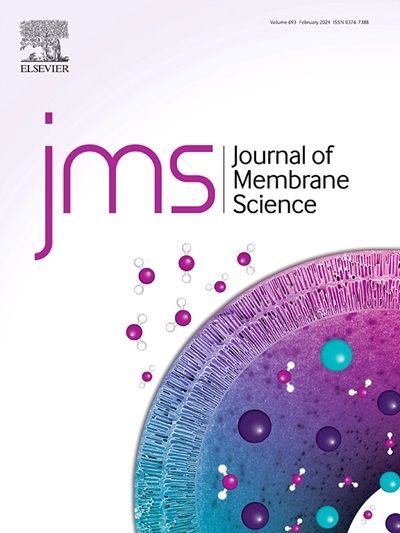High-efficiency water dissociation via natural polymer bipolar membranes with alginate/polydopamine-coated halloysite nanotubes and phosphotungstic acid
IF 8.4
1区 工程技术
Q1 ENGINEERING, CHEMICAL
引用次数: 0
Abstract
Bipolar membranes (BPMs), composed of anion exchange membrane (AEM) and cation exchange membrane (CEM), hold promise for energy and environmental applications due to their ability to dissociate water into H+ and OH− under reverse bias. However, their practical voltage requirements often exceed theoretical potentials, necessitating efficiency optimization. This study introduces an innovative BPM design integrating alginate (SA)-based CEM with chitosan AEM, enhanced by polydopamine-coated halloysite nanotubes (DHNTs) loaded with phosphotungstic acid (HPW). The tubular structure of the DHNTs, modified via dopamine polymerization, improved mechanical stability and proton conductivity, while HPW coating (optimized at 10 wt %) facilitated acid-base interactions, reducing proton hopping distances. Comprehensive characterization (SEM, FTIR, XPS, TGA) confirmed successful HPW coating and structural modification. The optimized BPM exhibited enhanced tensile strength than unmodified BPM with proton conductivity of 36.56 mS/cm and low water dissociation overpotential of 1.188 V at 70 mA/cm2. Electrodialysis tests revealed reduced interfacial resistance (IR drop) and increased stability over 48 h, attributed to HPW's catalytic role in accelerating ion transport and minimizing energy loss. The synergy between DHNTs and HPW significantly improved hydrophilicity, mechanical robustness, and energy efficiency, demonstrating the potential of this design for sustainable electrochemical systems. These findings provide critical insights into advanced BPM development for scalable energy and environmental technologies.

求助全文
约1分钟内获得全文
求助全文
来源期刊

Journal of Membrane Science
工程技术-高分子科学
CiteScore
17.10
自引率
17.90%
发文量
1031
审稿时长
2.5 months
期刊介绍:
The Journal of Membrane Science is a publication that focuses on membrane systems and is aimed at academic and industrial chemists, chemical engineers, materials scientists, and membranologists. It publishes original research and reviews on various aspects of membrane transport, membrane formation/structure, fouling, module/process design, and processes/applications. The journal primarily focuses on the structure, function, and performance of non-biological membranes but also includes papers that relate to biological membranes. The Journal of Membrane Science publishes Full Text Papers, State-of-the-Art Reviews, Letters to the Editor, and Perspectives.
 求助内容:
求助内容: 应助结果提醒方式:
应助结果提醒方式:


